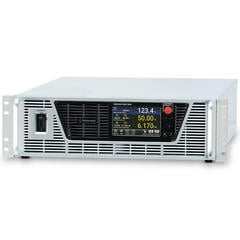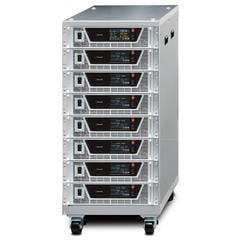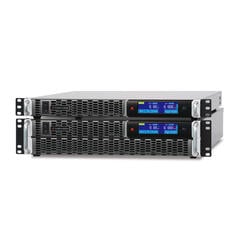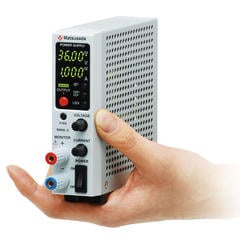Mechanism of Bidirectional Power Supply
First, let's define a bidirectional power supply. In essence, it is a device that manages a two-way flow of electrical energy, featuring converters for both AC/DC and DC/DC conversion. It supports both DC and AC by mounting a bidirectional DC/DC converter and a bidirectional AC/DC converter inside.
A key feature of a bidirectional power supply is its regenerative capability, which allows it to both source and sink (absorb) electrical energy. For this reason, this article uses the terms "bidirectional power supply" and "regenerative power supply" synonymously.
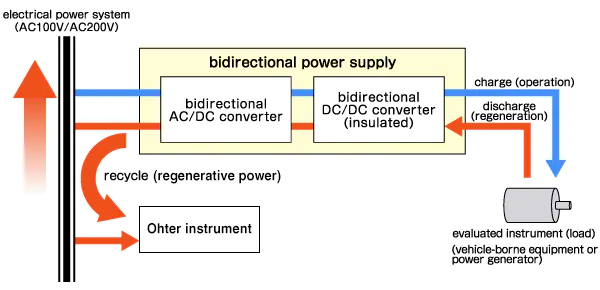
The figure below shows a schematic of the bidirectional power supply.

This mechanism makes it possible to exchange energy bidirectionally with commercial power sources. The circuit connected to the output to the device under test (DUT) is called the "regenerative power supply".
The circuit of the regenerative power supply can be roughly divided into three parts. Starting from the left side of the figure, there is a "1. bidirectional AC/DC converter". This is a circuit that can convert the commercial AC grid and internal DC current in both directions and exchange energy. Electricity converted from AC line to direct current can exchange energy bidirectionally while insulating DC on the primary side and DC on the secondary side through the "2. bidirectional DC/DC converter". This is also known as an isolation transformer. Finally, voltage conversion is performed by the "3. boost/step-down DC/DC converter". In particular, by using a variable voltage on the secondary side, it can be used for various tests.
Advantages of Using Bidirectional Power Supply
This bidirectional power supply is being developed further. Now, the types of small electronic devices have increased. During testing, it is necessary to understand how devices are affected by the voltage changes of a storage battery and what kind of circuit design is necessary to prevent the adverse effects.
In particular, the battery is characterized by "the voltage decreases as the output current increases," "the electrical characteristics differ between fully charged and low battery," and "the electrical characteristics differ between new and degraded products." In the general household, testing across a wide range of scenarios is crucial, since the condition of the battery in an end-user environment is unpredictable.
Therefore, the bidirectional power supply is used as a battery simulator. The DC power supply used as a simulator is generally marketed as a programmable power supply. This is further advanced, and bidirectional power supply as programmable power supply is currently developing.

Bidirectional power supplies that can achieve high voltages are used for high current converter tests for EVs, etc. In converter tests that involve repeated cycles of powering (sourcing) and regeneration (sinking), these power supplies enable smooth, seamless current transitions. They prevent notching at the crossover point and eliminate current waveform overshoot and undershoot. Repeated tests can be performed without worrying about overcharging, over-discharging, and deterioration of the rechargeable battery. The regenerative power supply can also be used as a CV/CC power supply or a CV/CV power supply.
Use Case 1: As a Constant Voltage/Constant Current (CV/CC) Power Supply
Use as a Constant Voltage/Constant Current power supply
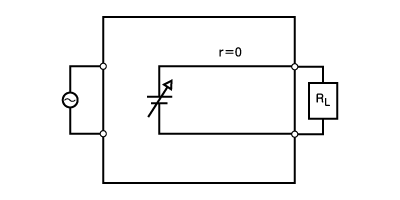
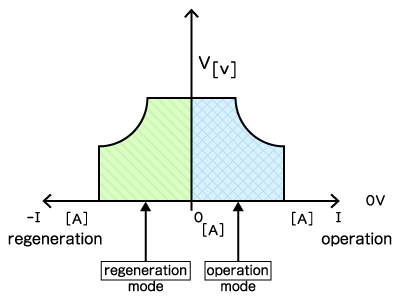
Consider a device that may experience voltage changes when connected to a system. To test if the system can withstand these fluctuations, the best method is to use a power supply that emulates them. This approach is often better than experimenting with the actual devices.
Conversely, it is also useful to find out how much voltage change the device can handle. If it is the same as the primary battery with a constant power supply, it should be connected to the usual power supply. But if it is a device to be used connected to a rechargeable battery, the state of voltage changes depending on the type of battery. If the bidirectional power supply is used well, it is possible to reproduce various voltage and voltage change storage batteries, such as lithium-ion batteries and lead-acid batteries. So it can reproduce from 12V car battery to high voltage for EV.
Use Case 2: Simulating a Battery's Internal Resistance
The internal resistance of the rechargeable battery can be set to reproduce the operation of the battery
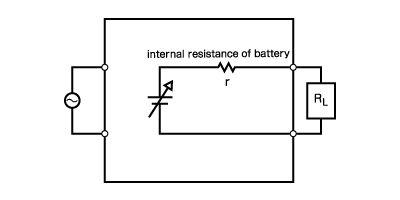
By adjusting the value 'r', it is possible to simulate how the internal resistance changes with the state of charge (SOC) and other parameters (SOD etc.)
Battery voltage can be changed by Constant Voltage setting when using as a CV power supply in the case r=0 (Ω)
Real-world batteries experience two types of degradation: permanent degradation, an irreversible decline from aging, and temporary degradation, a recoverable performance reduction, for instance, at low temperatures. So, the state of charge (SOC) of the battery is affected by the state of health (SOH) due to these two factors.
Assuming that permanent deterioration is SOH1 and temporary deterioration is SOH2, SOH = SOH1 X SOH2. Also, 1-SOH is called the state of degradation (SOD). In the regenerative power supply, by setting to simulate this SOD, it is possible to test how the electronic equipment behaves when connecting a deteriorated battery. This is used as "SOC estimation technology based on battery model".
It can also be used for testing on low-voltage electronics such as mobile devices. As mentioned above, it is not known in advance what kind of battery state in a general household is, so it is not only a new battery state by using the regenerative power source, but also the state and capacity of the deteriorated battery and capacity. It is possible to reproduce the voltage drop condition etc. near the end. Therefore, it is possible to repeat the operation test of the electronic device not only in the steady state but also in the abnormal state and the test of the malfunction prevention function.
Measurement example for V-I characteristics of lithium-ion battery (case of discharging)
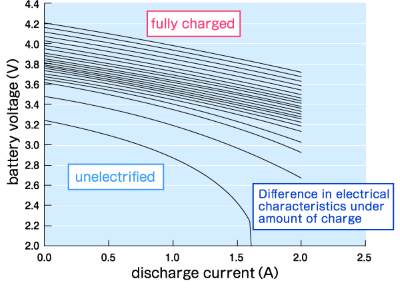
V-I characteristics
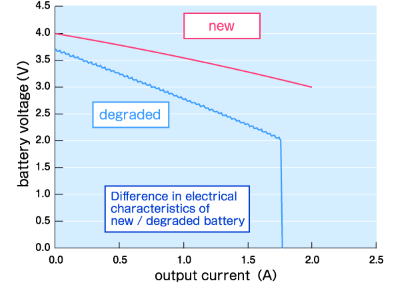
Besides, it can be used as an inverter simulator or a motor simulator.
On the other hand, it can be used besides electronic devices. For example, there are the on-board vehicle-mounted devices for a hybrid car that employs the "mild hybrid". In the case of the "48 V Mild Hybrid" proposed in Europe, we are using a decelerating energy regeneration system and an enhanced generator to help drive.
The on-board generator is usually 12 V, which supplies the power of the on-vehicle electrical components, but this voltage is too low for hybrid use. So, it is replaced by a 48 V generator. In other words, since the car's electronic equipment itself operates at 12 V as before, it needs voltage conversion. The bidirectional power supply which incorporates a bidirectional DC/DC converter etc. is carried in these conversions. Furthermore, it is possible to simulate whether this system works for a hybrid car well.
Of course, this technology is also about system linkage, so a bidirectional power supply can also be used in the system linkage part. We will introduce it next time.
Related Technical Articles
Recommended products
Matsusada Precision manufactures DC power supplies with regenerative functions, inverters, and power supply equipment used to evaluate batteries.
Reference (Japanese site)
- Japanese source page 「双方向電源の使われ方」
(https://www.matsusada.co.jp/column/column-bi-directional-power-supply.html) - 双方向 DC/DC コンバータの各種回路方式
(https://hirachi.cocolog-nifty.com/kh/files/29160601-1.pdf) - 双方向DC-DCコンバータと蓄電システムの協調によるスマートなパワーシステム
(https://product.tdk.com/ja/techlibrary/applicationnote/power-system_bidirect-converter.html) - 電気が伝わる経路(電気事業連合会)
(https://www.fepc.or.jp/enterprise/souden/keiro/) - 48Vマイルドハイブリッドシステムとは?仕組みや燃費への効果も全て解説!
(https://carblo.net/48v-mild-hybrid-system) - 「バッテリマネジメント工学」足立修一・廣田幸嗣編著 東京電機大学出版局刊
(https://www.tdupress.jp/book/b348995.html) - 「電気自動車工学」廣田幸嗣・小笠原悟司編著 森北出版株式会社刊
(https://www.morikita.co.jp/books/mid/074311)



